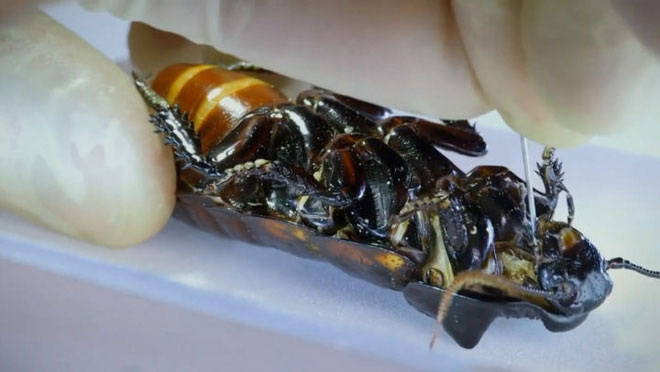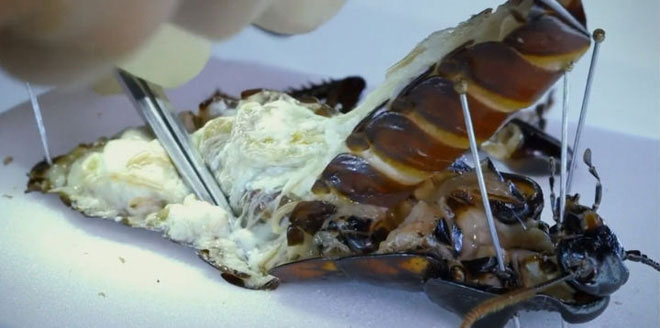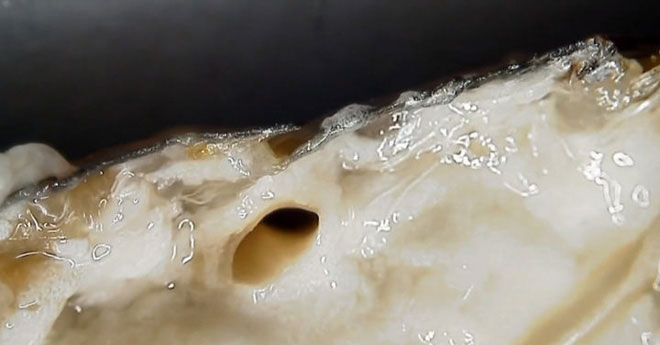Why do insects have such a small size? Why do cockroaches lose their heads and still live?
When you hear that if you cut off the head of a cockroach, it will not die by that cut, but instead die of hunger, will you believe that?
And have you ever wondered why the bodies of insects today are so small?
In fact, there are many theories born to explain these questions, but most of them have yet to explain the exact mechanism behind the limited size of many insects in the world. modern.
To find out and answer that question, the young entomologists Brandon Dengfei and James Rogan conducted an operation on cockroaches to help us understand the internal structure of their body.
The external structure of almost all insects is essentially the same, divided into head, chest and abdomen, all protected by exoskeletons - the exoskeleton .
These exoskeletons are hard and brittle, without the professional tools, insect anatomy will become very tough and disrupt their internal structures.

When we open the exoskeleton of the abdomen, we will see its body filled with slimy white material. This is the tissue that stores nutrients such as proteins and fats in their bodies, and is also the substance we see expelled from the body after we're beaten to death.

After removing the entire layer of white matter, their internal organs will be visible, but contrary to the internal structure of the human body. Insects don't need a heart , they do n't need lungs to breathe like most other animals on the planet.

Why are giant insects always found only in fiction, but in reality, insects are always very small?
Insects are different from us, they breathe thanks to the pores on both sides of the body to breathe , it is an open gas exchange system, the air will automatically circulate and move to other organs. each other in the body.

This form of breathing is very different from us and also somewhat confusing, but it is also one of the reasons that limits their size, making them have small bodies like what we often see.
For most insects, this open respiratory system is considered a limited part for long flights because the breathing tubes inside the body account for a relatively large proportion and volume compared to them.
If their bodies grow larger, which means a higher demand for oxygen absorption, the car breathing tubes expand but it seems that the breathing tubes will no longer suit the large body because they are easily blocked if stored. Air transfer at high speed when flying.

But this explanation is not entirely true, in the past, mankind has discovered many fossils of giant insects, which shows that giant insects actually exist on Earth. . So how to explain that?
In many other articles related to the size of organisms and the environment in ancient times, you will probably think of factors such as temperature, nutrition, and especially oxygen and fencing at that time.

Indeed, 3-4 billion years ago, the oxygen content of the Earth's atmosphere was about 30% higher than today due to the flourishing growth of plants, which undoubtedly significantly improved coral efficiency. As a result, the limitations of the open respiratory system on insects today were almost nonexistent at the time.
To prove that, scientists conducted experiments to track the difference and showed that insects raised in high oxygen content will have the body grow larger and longer than 20- 25% compared to insects raised under normal conditions.

Although insects' respiratory systems are very different from ours, their digestive systems are much more similar to ours. The system also includes a digestive tract that extends from the mouth to the anus, also having structures like the esophagus, stomach, and intestines.
But their digestive system is more efficient than mammals because nutrients pass directly through the walls of the digestive tract, to nearby organs, and the rest is turned into fat.

Not only that, the insect's neural structure is also very special, which leads to differences in their brains.
Insects possess a simple brain structure, often very small. Even if these insects were the size of a human, their brains could only be as big as a walnut.

This small brain is used to control various high-level activities, such as the visual senses, but this brain is actually not necessary for their survival.
When anatomically operated from an insect's back, you can find a nerve and lymph node between white mucus.
These neural structures are similar to the human nerve center, but their function is somewhat "superior" to that of the mammalian nerves.

These nodes are distributed evenly throughout the insect's body and are responsible for controlling nearby organs.
For example, lymph nodes located in the chest should control cows and fly (if winged). In other words, the insect's brain is not only placed on the head, but distributed throughout the body, they control the basis of breathing, eating, digestion, etc. Activity.
Therefore, when a cockroach loses its head, it will not die from the loss of its brain. They will only die of starvation or water shortage due to head loss.
- Why can cockroaches live even when they have ... lost their heads?
- What would life be without ... cockroaches?
- Crying with scary facts about death
- Severe shock when detecting cockroaches living in the skull
- Cockroaches 'invasion' city of Italy
- The secret of cockroaches
- Humans will perish before cockroaches?
- Insecticides can kill 3 generations of cockroaches
- Giants in the insect world
- Horror giant cockroach crawling on people's hands, being a pet
- Catastrophic flying disaster: Why do they always face us straight down?
- Turn cockroaches into fuel cells
 Why do potatoes have eyes?
Why do potatoes have eyes? 'Tragedy' the world's largest carnivorous life: Death becomes ... public toilet
'Tragedy' the world's largest carnivorous life: Death becomes ... public toilet Tomatoes were once considered 'poisonous' for 200 years
Tomatoes were once considered 'poisonous' for 200 years Detecting microscopic parasites on human face
Detecting microscopic parasites on human face